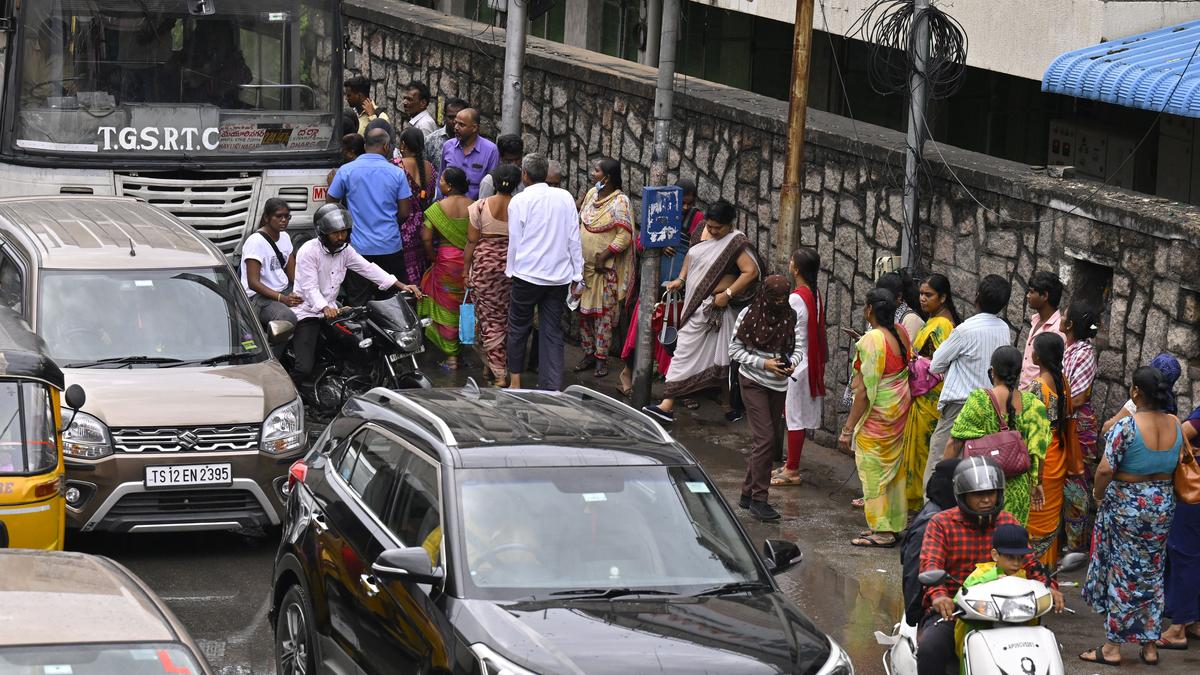
The pavement predicament: A priority for passenger safety in Hyderabad Premium
The Hindu
TGSRTC bus safety campaign highlights the lack of footpaths at Hyderabad bus stops, urging better pedestrian infrastructure citywide.
Just a month ago, a 16-year-old girl returning home after her first day of college was crushed under the wheels of a Telangana State Road Transport Corporation (TGSRTC) bus, moments after disembarking in the middle of the road in Madhura Nagar, Hyderabad. The disturbing visual went viral on social media, sending shockwaves among daily commuters. In the aftermath of the incident, the TGSRTC launched a passenger safety campaign, urging people to avoid waiting for buses on the carriageway and instead, use footpaths at bus stops. Photographs released by the transport corporation to buttress the point showed a stop which, unfortunately, had no footpaths. The irony made one sit up and take notice of the glaring lack of passenger-friendly infrastructure.
The transport juggernaut is, of course, right; the carriageway is meant for vehicular movement, and pedestrian activity on it is perilous. However, the fact is that many bus stops lack footpaths, either swallowed whole overnight due to road widening or painfully encroached upon inch-by-inch.
A case in point is the bus stop at Panjagutta Crossroads, one of the busiest intersections in Hyderabad. Throughout the day and well into the evening, passengers are forced to navigate through a tide of vehicles driven by unsympathetic drivers and sewage water spilling onto the narrow carriageway to reach this bus stop.
“I usually take the 49M bus to reach the clothing store near Begumpet where I work as a salesman. I have to walk from the Nagarjuna Circle, about 200 metres away, to reach the stop. There is no footpath, because of which you can see hordes of people waiting on the road,” says Sk Jahangir,30.
Farida Banu, who works as a domestic help in the plush locality of Banjara Hills in the city, usually takes the 9 Y/F bus route to drop her daughter off near Borabanda to reach her in-laws’ place. She boards the bus at the ‘Paani ki Tanki’ (water tank) stop, located along the bustling Banjara Hills Road Number 1, opposite an upscale shopping mall. “My stop has both, a footpath and a shelter, but the disembarking point, Sriram Nagar, does not have either,” she says.
In another part of the city, an ordinary bus, plying barely a few metres behind a metro express, groans and grunts as it trudges along the Mandi Mir Alam Road. Serving the 8A route, one of the oldest in the 90-year history of the TGSRTC, once a part of the Nizam’s Road Transport Department, it connects Secunderabad to Chandrayangutta. The bus passes by a disused bus shelter, now an autorickshaw parking stand, near Princess Esin School. Then, from the famous Victoria Hotel, the driver takes a sharp right turn and stops where a father and daughter wait on the carriageway to board. Continuing towards Hafiz Danka Masjid, a rotunda-like mosque in Hyderabad’s Old City, it halts at Shalibanda bus stop, which surprisingly lacks a pavement despite having a bus shelter. Footpaths on the 8A route are also missing at various stops like SBI Shamsheergunj, Aliabad, Falaknuma, and Falaknuma Bridge, and mirror similar deficiencies on the opposite side of the road.
“I take the 9F bus from Falaknuma to Kukatpally. At times, the 8A bus stops here as well. There is no footpath near the Grand Hotel bus stop in Falaknuma. This proves to be a problem during peak traffic hours,” says Syed Kaleem, a final year law student.













